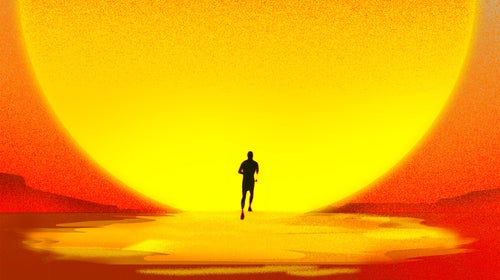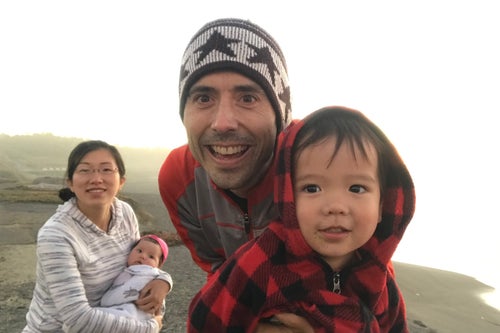Philip Kreycik Wasn’t Supposed to Die This Way
He was an environmentalist versed in the dangers of our warming world, an expert trail runner, and eminently capable of moving far and fast outside. The heat killed him all the same.
Heading out the door? Read this article on the Outside app available now on iOS devices for members! Download the app.
A few days after the Fourth of July in 2021, Chris Thoburn swiped open his texts to see two waiting from his friend Philip Kreycik.
“I’ve got a free pass Friday night and Saturday morning if you’re up for a run,” Kreycik wrote. His wife, Jen, had taken their kids, ages ten months and three years, to visit her parents for the night.
Kreycik, 37, and Thoburn, 32, had been friends since Kreycik moved to Berkeley in 2017. They’d met on Strava, when Thoburn spotted Kreycik dropping fast times on some steep trails and reached out about meeting up. Over the years, they’d run all over the Bay Area.
It would be fun, Kreycik’s second text read, to check out somewhere new.
Though their only time together was spent running, the pair had become close, spending long runs talking about their lives. Thoburn, a software engineer, was trying to become a professional ultrarunner. Kreycik had just started a new job at Pacific Gas & Electric, developing the utility giant’s electric- vehicle charging strategy.
“Very interested,” Thoburn shot back. The men settled on a mellow Friday-evening run in the Oakland hills.
Another runner met them there, and when the trio stopped that night at the Redwood Peak summit around sunset, it was still warm out. News reports that week had warned of approaching triple-digit temperatures, the latest in a series of record-breaking heat waves that baked the West all through that summer and had already killed hundreds of people across the Pacific Northwest. That night and in the coming days, nearly all of Northern California was under an excessive-heat warning, but the most dangerous temperatures would be felt only farther east, too far from the ocean to feel its cooling effects.
In Oakland, it was a rare and perfect 80-degree night. Thoburn unzipped his pack and passed each man a beer. They talked about the weekend, and Kreycik’s hopes to run. His drive to meet his family at Jen’s parents’ house in Stockton, 90 minutes east, seemed like a good opportunity to try a new route in the vast network of parks along the way.
Back home that night, Kreycik opened Strava and mapped a nine-mile loop in Pleasanton Ridge Regional Park, a 9,100-acre swath of public land 30 minutes southeast of Berkeley. The run might take a little over an hour. The trailhead, in a neighborhood near the park, was just a mile off the 580 freeway.
Saturday morning, Kreycik talked to Jen on the phone. Make sure to wear sunscreen, she told him, and bring water. She was worried about the heat. “Of course,” he said.
He texted her from the trailhead later that morning: “Eta 12:35ish.” That didn’t give him enough time for the full loop he’d planned, but the route was easy to modify—he’d take a straight shot up to the ridge, then out on the Northridge Trail until he ran out of time. He pulled off his shirt and tucked his phone under the front seat.
He left his water bottle in the center console, locked the Prius, clicked start on his Suunto sports watch, and set off down the narrow dirt track. The trail dipped into the oak and laurel trees, hugging the side of a ravine before turning steeply upward toward the ridge. It was 10:49 A.M. A nearby weather station registered the temperature at 87.
Kreycik pushed hard, his five-foot-11-inch frame all elbows and angles under a sweep of overgrown brown hair. He broke course records on nearly every Strava segment he covered, laying down times most runners would be hard-pressed to beat, even on a cooler day.
Cresting the ridge, the trail opened up into sweeping views of the rolling landscape below: the earth like a wrinkled hide under a stubble of golden grass, with oak-forest oases in every canyon crease.
At the Northridge Trail intersection, the access gate was closed, but the lowest strand of barbed wire strung beside it was usually loose, and many trail users just slipped underneath. Kreycik turned south into the park.
A few minutes later, he took a side trail. Then, 25 minutes into his run, at a T in the trail, he turned around, leaving a single footprint in the dust.
As Kreycik’s 12:35 arrival approached, Jen pulled out her phone to check his location and ETA. Google Maps showed that his phone was still at the trailhead parking lot in Pleasanton. Annoyed and confused, she delayed their meal. By 2 P.M., Jen and her parents had given up waiting, and Jen called Kreycik’s folks to see if they’d heard from him. Wait an hour, Keith and Marcia Kreycik suggested, then try the police. Cops make welfare checks all the time, they said. It’s probably nothing.
Jen hung up. She waited five more minutes, then dialed.



